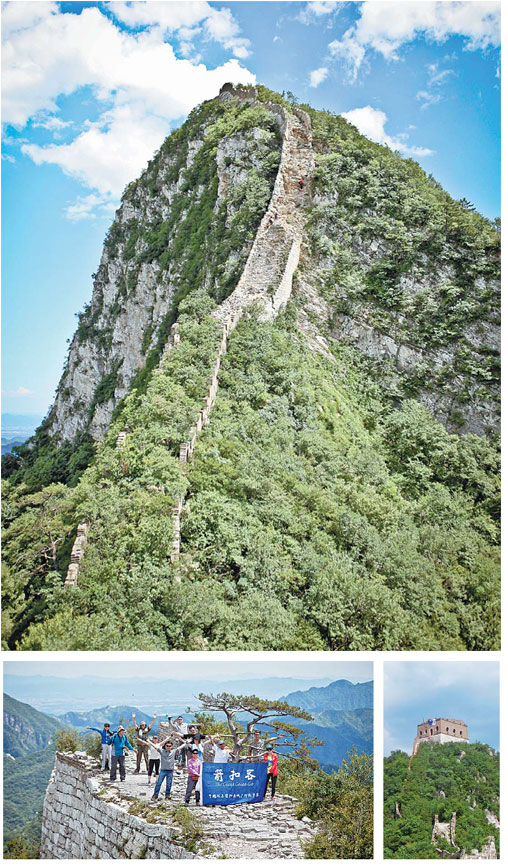Dangerous and beautiful
Updated: 2014-08-23 07:43
By Xu Lin(China Daily)
|
||||||||
Weekend Excursion
Climbers die almost every year attempting to tackle this remote part of the Great Wall.
Only after you conquer the challenging Jiankou Great Wall will you understand the true meaning of the popular Chinese saying that goes, "He who has never been to the Great Wall is not a true man."
|
Clockwise: People fall from the watch tower named "the eagle flies facing upward" and die nearly every year; You can camp near Zhengbeilou Tower, a perfect location for the sunset and sunrise; Members of the Giant Gooo-go Great Wall go to Jiankou Great Wall every Saturday. Provided to China Daily |
As an unprotected wild Great Wall section, Jiankou has become a photographic hotspot and hiking destination for its picturesque views and precipitous mountains in recent years.
The 20-kilometer long Jiankou, which lies to the west of Mutianyu Great Wall, was built in Tang Dynasty (AD 618-907) and Ming Dynasty (1368-1644) with large white dolomites.
It was called Jiankou, which literally means arrow nock, because the long and winding Great Wall on the mountain looks like a W-shaped archer's bow and the collapsed ridge is just like the back end of an arrow.
It's different from the more famous Badaling and Mutianyu Great Walls in Beijing, which are well-renovated with gentle slopes and frequented by tourists of all ages.
Weathered by years of wind and rain, Jiankou has fallen into disrepair with steep cliffs and rough steps, making it one of the capital's most well-known outdoor places for its sense of danger.
"Some tourists have fallen to their deaths accidentally because they are not familiar with the landform. It's better to climb Jiankou with experienced people," says Zou Yi, 53, who organizes outdoors enthusiasts to visit Jiankou every Saturday and take away the rubbish left by others to protect the environment. The group members call themselves "the Giant Gooo-go Great Wall", and they guide me to Jiankou.

It takes about two and a half hours to drive to the Jiankou Great Wall from Beijing's downtown. You have to wear mountaineering shoes and skid-proof gloves. Prepare a simple lunch and pack sufficient water. Make sure you have enough food and water if you plan to camp at night.

When we arrive at the Xizhazi Village, we stop at first in a simple restroom because there are no toilets on the Great Wall. The wall here has no entrance fee as it is unattended, but the villagers will charge you a ticket to the village for 20 yuan ($3.27) per person and parking fees.

After climbing awhile on a zig-zagging path up the mountain, we come to one of the beacon towers and are shocked by the nearly vertical and dilapidated Great Wall in front of us.
We head for the east part of Jiankou, which is a bit easier to climb than the west part. It's like rock climbing, and I have to use my hands and feet to keep balance. There are no guard bars for protection, so I tried my best to be as careful as I can.
Sometimes we need to help each other in danger. When I struggled to climb the steep slope and tried to crouch to the ground, one man stood on the adjacent bricks and caught my hands. If I had lost my balance at that time, I would have fallen down the cliff. He risks his life as well because beyond the bricks is the cliff face.

One of the most dangerous parts of Jiankou is the watch tower named "the eagle flies facing upward", meaning that even an eagle flying by has to face upwards to see the top tower.
According to Zou, people fall from the tower and die nearly every year because when they try to go down from the vertical steps, they have no idea that about 4 meters of the stone steps have disintegrated due to years of erosion.
"My suggestion is, don't try an unfamiliar route. Please remember that in each dangerous location, there must be another safe detour out," Zou says. He recently persuaded a young man to give up when he saw the man was trying to challenge the tower.
Each of us ties a garbage bag to our bag, and when we came to a gentle slope, we gathered rubbish such as plastic bottles and disposal chopsticks, and take them away when we go downhill.
"When I first came to Jiankou, I was attracted to its beauty instantly but felt sad to see a lot of garbage on it. Jiankou is like my home and I want to keep it clean. It's important to take away all your rubbish when you come here, " Zou says.

When we finally arrived at Zhengbeilou Tower, some group members start to pitch their tents on the Great Wall, so they will have a perfect location to watch the sunset and sunrise. Some even take out their yoga mattresses to do exercise.
I felt lucky to be able to enjoy the magnificent views of the mountain and the winding Great Wall from near to far. The rugged, unrestored section seemed to tell its own story with its broken rocks and steep stone steps.

It's best to start to go downhill before 5 pm in summer and two hours earlier in winter because when the sun goes down, you can hardly see the road as there are no artificial lights on the Great Wall.
Jiankou's natural beauty differs in four seasons. You will see pink peach flowers and white pear flowers in spring, and colorful leaves in autumn, and stunning snow views in winter.
Contact the author at xulin@chinadaily.com.cn
(China Daily 08/23/2014 page18)

 Star Stefanie Sun holds concert in Beijing
Star Stefanie Sun holds concert in Beijing
 Faye Wong's manager refutes star's drug rumors
Faye Wong's manager refutes star's drug rumors
 Lu Yi and daughter Bei Er pose for street snaps
Lu Yi and daughter Bei Er pose for street snaps
 Photoshoots of actress Li Xiaomeng
Photoshoots of actress Li Xiaomeng
 Council of Fashion Designers of America Awards
Council of Fashion Designers of America Awards
 Fan Bingbing, first Chinese actress in Barbie Hall of Fame
Fan Bingbing, first Chinese actress in Barbie Hall of Fame
 Awarding ceremony of 2014 hito Pop Music held in Taipei
Awarding ceremony of 2014 hito Pop Music held in Taipei
 Zhao Liying's photo shoot for Children's Day
Zhao Liying's photo shoot for Children's Day
Most Viewed
Editor's Picks

|

|

|

|

|

|
Today's Top News
US, China to parley on extradition of criminals
US rice could see potential market in China
China accuses US over 'close-in reconnaissance'
EB-5 visa ceiling is short-term, expert says
China and US in talks on code of conduct
Chicken market gets a boost
Microsoft 'not fully open with sales data'
Lawmakers in move to tackle espionage threat
US Weekly

|

|









